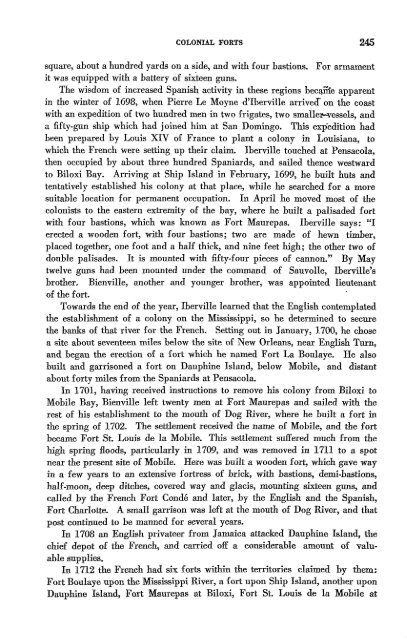THE COAST ARTILLERY JOURNAL - Air Defense Artillery
THE COAST ARTILLERY JOURNAL - Air Defense Artillery
THE COAST ARTILLERY JOURNAL - Air Defense Artillery
Create successful ePaper yourself
Turn your PDF publications into a flip-book with our unique Google optimized e-Paper software.
COLONUL FORTS 245<br />
square, about a hundred yards on a side, and with four bastions. For armament<br />
it was equipped with a battery of sixteen guns.<br />
The wisdom of increased Spanish activity in these regions becqille apparent<br />
in the winter of 1698, when Pierre Le Moyne d'Iberville arrived on the coast<br />
with an expedition of two hundred men in two frigates, two smallel'-'Vessels,and<br />
a fifty-gun ship which had joined him at San Domingo. This expedition had<br />
been prepared by Louis XIV of France to plant a colony in Louisiana, to<br />
which the French were setting np their claim. Iberville touched at Pensacola,<br />
then occupied by about three hundred Spaniards, and sailed thence westward<br />
to Biloxi Bay. Arriving at Ship Island in February, 1699, he built huts and<br />
tentatively established his colony at that place, while he searched for a more<br />
suitable location for permanent occupation. In April he moved most of the<br />
colonists to the eastern extremity of the bay, where he built a palisaded fort<br />
with four bastions, which was known as Fort Maurepas. Iberville says: "I<br />
erected a wooden fort, with four bastions; two are made of hewn timber,<br />
placed together, one foot and a half thick, and nine feet high; the other two of<br />
double palisades. It is mounted with fifty-four pieces of cannon." By May<br />
twelve guns had been mounted under the command of Sauvolle, Iberville's<br />
brother. Bienville, another and younger brother, was appointed lieutenant<br />
of the fort.<br />
Towards the end of the year, Iberville learned that the English contemplated<br />
the establishment of a colony on the Mississippi, so he determined to secure<br />
the banks of that river for the French. Setting out in January, 1700, he chose<br />
a site about seventeen miles below the site of New Orleans, near English Turn,<br />
and began the erection of a fort which he named Fort La Boulaye. He also<br />
built and garrisoned a fort on Dauphine Island, below Mobile, and distant<br />
about forty miles from the Spaniards at Pensacola.<br />
In 1701, having received instructions to remove his colony from Biloxi to<br />
Mobile Bay, Bienville left twenty men at Fort Maurepas and sailed with the<br />
rest of his establishment to the mouth of Dog River, where he built a fort in<br />
the spring of 1702. The settlement received the name of Mobile, and the fort<br />
became Fort St. Louis de la Mobile. This settlement suffered much from the<br />
high spring floods, particularly in 1709, and was removed in 1711 to a spot<br />
near the present site of Mobile. Here was built a wooden fort, which gave way<br />
in a few years to an extensive fortress of brick, with bastions, demi-bastions,<br />
half-moon, deep ditches, covered way and glacis, mounting sixteen guns, and<br />
called by the French Fort Conde and later, by the English and the Spanish,<br />
Fort Charlotte. A small garrison was left at the mouth of Dog River, and that<br />
post continued to be manned for several years.<br />
In 1708 an English privateer from Jamaica attacked Dauphine Island, the<br />
chief depot of the French, and carried off a considerable amount of valuable<br />
supplies.<br />
In 1712 the French had six forts within the territories claimed by them:<br />
Fort Boulaye upon the Mississippi River, a fort upon Ship Island, another upon<br />
Dauphine Island, Fort Maurepas at Biloxi, Fort St. Louis de la Mobile at
















